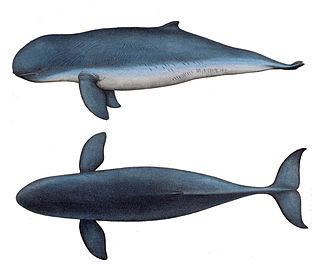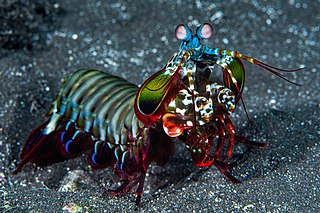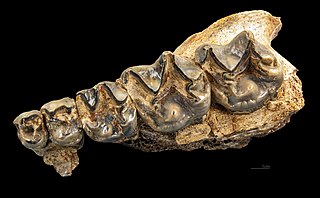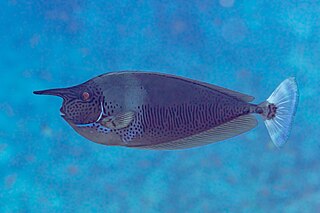
The snubfin dolphins (Orcaella) are a genus of cetaceans containing two members: the Irrawaddy dolphin and the Australian snubfin dolphin. The genus was long believed to be monotypic with the only species being the Irrawaddy dolphin; however, in 2005, supposed Irrawaddy dolphin populations inhabiting the Australian/New Guinean regions were found to be significantly different and were declared a separate new species named the Australian snubfin dolphin.

The lemon shark is a species of shark from the family Carcharhinidae, known for its yellowish color, which even gives it its popular name. It is classified as a Vulnerable species by the International Union for the Conservation of Nature. Lemon sharks can grow to 3.4 metres (11 ft) in length. They are often found in shallow subtropical waters and are known to inhabit and return to specific nursery sites for breeding. Often feeding at night, these sharks use electroreceptors to find their main source of prey, fish. Lemon sharks enjoy the many benefits of group living such as enhanced communication, courtship, predatory behavior, and protection. This species of shark gives birth to live young, and the females are polyandrous and have a biennial reproductive cycle. Lemon sharks are not thought to be a large threat to humans; there have been 10 recorded bites, none of which were life-threatening. The lemon shark's life span is unknown, but the average shark is 25 to 30 years old. The oldest recorded lemon shark in captivity died in 2023 at the age of 40 years.

Odontodactylus is a genus of mantis shrimp, the only genus in the family Odontodactylidae. Mantis shrimp of the genus Odontodactylus can not only detect circular polarisation of light, but can also detect polarised light reflecting off their telson and uropods.

Pachycrocuta is an extinct genus of prehistoric hyenas. The largest and most well-researched species is Pachycrocuta brevirostris, colloquially known as the giant short-faced hyena as it stood about 90–100 cm (35–39 in) at the shoulder and it is estimated to have averaged 110 kg (240 lb) in weight, approaching the size of a lioness, making it the largest known hyena. Pachycrocuta first appeared during the late Miocene. By 800,000 years ago, it became locally extinct in Europe, with it surviving in East Asia until at least 500,000 years ago, and possibly later elsewhere in Asia. There is a possibility the extant brown hyena is a member of this genus, along with the extinct Pliocrocuta and "Hyaena" prisca.

Chalicotherium is a genus of extinct odd-toed ungulates of the order Perissodactyla and family Chalicotheriidae. The genus is known from Europe and Asia, from the Middle Miocene to Late Miocene.

Varanops is an extinct genus of Early Permian varanopid known from Texas and Oklahoma of the United States. It was first named by Samuel Wendell Williston in 1911 as a second species of Varanosaurus, Varanosaurus brevirostris. In 1914, Samuel W. Williston reassigned it to its own genus and the type species is Varanops brevirostris.

Metriorhynchus is an extinct genus of marine crocodyliform that lived in the oceans during the Late Jurassic. The type species, M. brevirostris was named in 1829 as a species of Steneosaurus before being named as a separate genus by the German palaeontologist Christian von Meyer in 1832. The name Metriorhynchus means "Moderate snout", and is derived from the Greek Metrio- ("moderate") and -rhynchos ("snout").

The weebill is a species of bird in the family Acanthizidae. It is an insectivorous passerine that is found throughout mainland Australia. At 8 to 9 cm long, it is Australia's smallest bird. It was originally described by John Gould in 1838, and four subspecies are recognised. The weebill's plumage is nondescript, with olive-grey upperparts and paler, more yellowish underparts. It grades from more brownish plumage in the southern regions of Australia to more yellow in tropical areas.

The Kerguelen petrel is a small slate-grey seabird in the family Procellariidae. It is the only species placed in the genus Aphrodroma. It is a pelagic, circumpolar seabird of the Southern Ocean. It breeds on islands in the southern Atlantic and Indian Oceans.

Negaprion is a genus of requiem sharks in the family Carcharhinidae. It contains the two extant species of lemon sharks: the lemon shark of the Americas, and the sicklefin lemon shark of the Indo-Pacific. Both species are large, slow-moving, bulky sharks inhabiting shallow coastal waters, and can be identified by their short, blunt snouts, two dorsal fins of nearly equal size, and uniform yellowish brown or gray coloration.

The rusty tinamou or short-billed tinamou is a type of tinamou commonly found in swamp forest in tropical regions of South America.

Tomarctus is a canid genus of the extinct subfamily Borophaginae which inhabited most of North America during the late Early Miocene to the Early Barstovian age of the Middle Miocene. Tomarctus existed for approximately 6.83 million years.

Naso brevirostris, also known as the short-nosed unicornfish, spotted unicornfish, brown unicornfish, lined unicornfish, longnose surgeonfish, palefin unicornfish, paletail unicornfish, shorthorned unicornfish or shortsnouted unicornfish, is a species of marine ray-finned fish belonging to the family Acanthuridae, the surgeonfishes, unicornfishes and tangs. It occurs in the Indian and western Pacific Oceans.

Parakannemeyeria is an extinct genus of dicynodont. Fossils of the genus have been found in the Ermaying, Tongchuan and Kelamayi Formations of China.
Chromis brevirostris, or colloquially known as the shortsnout chromis, is a type of damselfish that was described in 2008 by R. Pyle, J. Earle, and B. Greene in the western Pacific Ocean. This species comes from the genus Chromis which contains eighty species and counting, including C. abyssus, C. circumaurea, C. degruyi, and C. earina. Chromis brevirostris can be found in the Pacific Ocean, located as far north as the Marshall Islands to as far south as Fiji and Vanuatu, and spanning from Palau to Paluwat of the Caroline Islands. The species’ name, Chromis brevirostris, derives from Latin origin; brevis and rostrum mean “short” and “snout” respectively. It is generally abundant in its environment, living at depths of 90–120 metres (300–390 ft), tending to live in groups ranging in size from six to several dozen.

Pliocrocuta is an extinct genus of hyena. It contains the species Pliocrocuta perrieri, known from the Pliocene to Early Pleistocene of Eurasia and possibly Africa. It is possibly ancestral to Pachycrocuta.
The Rubbernose conger is an eel in the family Congridae. It was described by Johnson T. F. Chen and Herman Ting-Chen Weng in 1967, originally under the genus Rhynchoconger. It is a marine, tropical eel which is known from the western Pacific Ocean, including Taiwan and Australia. It dwells at a depth range of 280 to 440 metres. Males can reach a maximum total length of 36.7 centimetres (1.20 ft).
The snubnose snake eel is an eel in the family Ophichthidae. It was described by John E. McCosker and Steve W. Ross in 2007. It is a marine, subtropical eel which is known from North Carolina, USA, in the western central Atlantic Ocean. It dwells at a depth range of 370 to 440 meters. Females can reach a total length of 29.2 centimeters (11.5 in).
Wangosaurus is an extinct genus of basal pistosauroid known from the Middle Triassic Falang Formation of Xingyi in Guizhou Province, southwestern China. It contains a single species, Wangosaurus brevirostris, first described and named by Le-Tian Ma, Da-Yong Jiang, Olivier Rieppel, Ryosuke Motani and Andrea Tintori in 2015. The specific name brevirostris comes from Greek for "short snout". It is known solely from its holotype, a nearly complete and articulated skeleton measuring 2.2 m (7.2 ft) long.
Caiman brevirostris is an extinct species of caiman that lived during the Late Miocene, around 11.6 million years ago, to the end of the Miocene 5.3 million years ago in Acre and Amazonas, Brazil as well as Urumaco, Venezuela. Several specimens have been referred to the species, but only 3 of them are confidently placed in the species. C. brevirostris was originally named in 1987 on the basis of a single, incomplete rostrum with an associated mandibular ramus that had been found in Acre, Brazil. C. brevirostris is very distinct among Caiman species and caimaninae overall in that it preserves a characteristically short and robust skull that bears blunt posterior teeth that were built to break down harder foods. This was an adaption for durophagy, likely to crush shells of mollusks and clams which were common in the wetlands that C. brevirostris resided in.




















